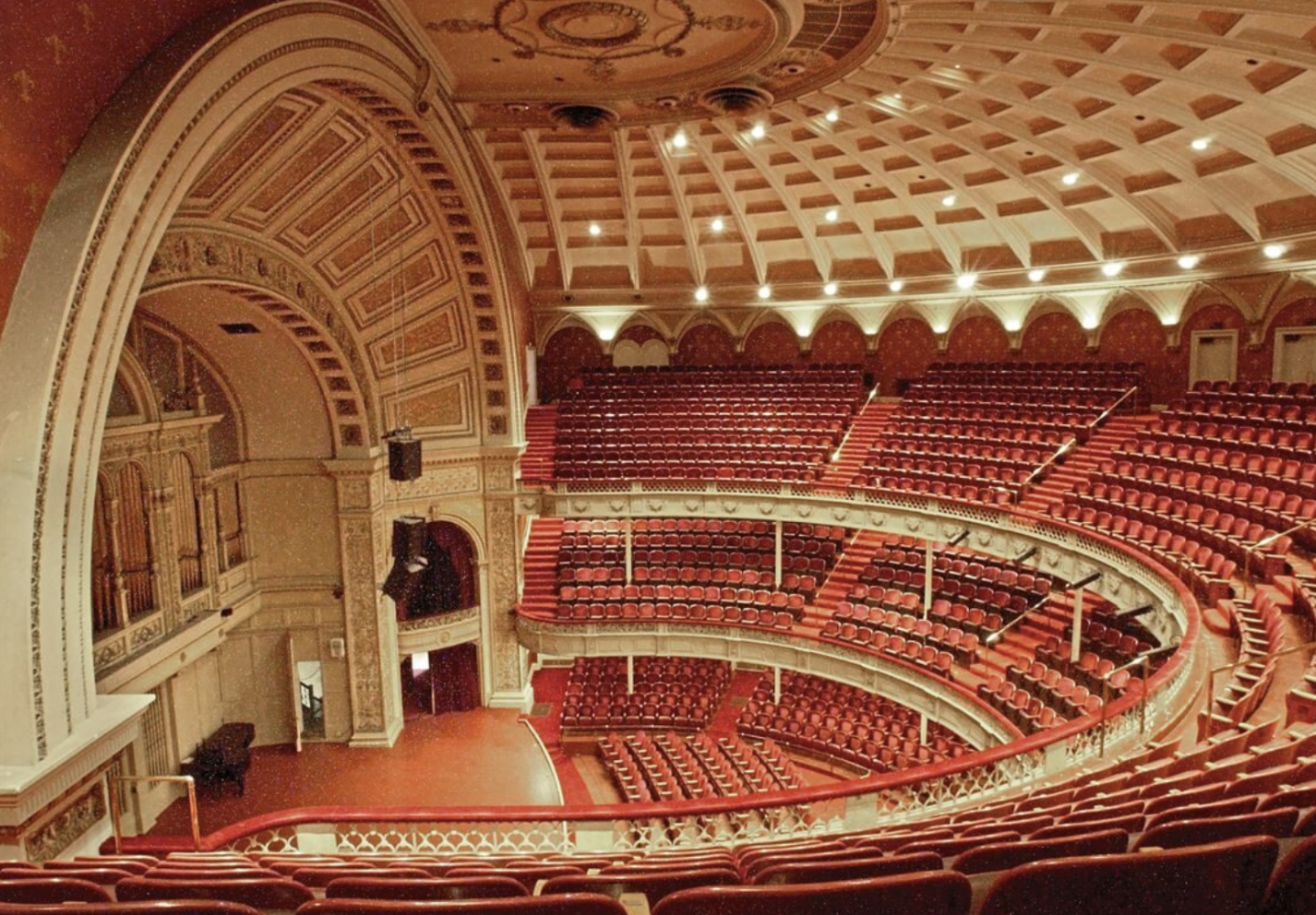Patterns of Authority: Sound is Spatial (II)
“Carnegie Music Hall.” Lewis and Clark Trail Experience, 2025.
Robin Sparkes July 10, 2025
The social construction of space provides a vital lens through which to examine how architectural acoustics function as tools within a system of regulation. Henri Lefebvre’s The Production of Space provides a comprehensive framework for understanding how spaces are socially constructed and used to maintain power. He writes, "Space is not a thing but rather a set of relations between things, a product of social interactions" (Lefebvre). This perspective resonates with architectural acoustics, as the design of spaces influences how sound is produced, transmitted, and experienced.
The spatial organization of a concert hall amplifies certain frequencies to enhance auditory experiences, while urban planning decisions often prioritize industrial sounds over human comfort. Carnegie Hall was designed by architect William Burnet Tuthill. Opened in 1891 in New York City, itis renowned for its exceptional acoustics due its sound duration for different pitches, where low and high frequencies resonate evenly throughout the room. The Hall’s initial programming for classical music, aimed at the upper class, exemplifies how spatial configurations not only influence acoustic experiences but reflect social value and hierarchy. The elliptical shape, smooth interior surfaces, slightly extended stage, and domed ceiling ensure that both soft and loud tones are projected with equal clarity throughout the venue.
Tuthill’s design choices align with the Renaissance pursuit of harmonic proportions, creating both visual and auditory harmony. Lefebvre argues that space is not merely a physical container but a product of social interactions and relations. In this light, Carnegie Hall’s design both reflects and reinforces the social hierarchies and cultural values of its time.. Examining its architectural and acoustic design through Lefebvre's spatial theory reveals how such spaces function as instruments that both reflect and shape societal values and hierarchies.
*
Patterns in Space
Acoustemology, a concept developed by Steven Feld in his studies of the Kaluli people, challenges the traditional visual-centric understanding of space. Feld demonstrates how soundscapes—the sonic equivalent of landscapes—reveal spatial patterns and societal structures. For the Kaluli, Feld notes in Sound and Sentiment, waterfalls, bird calls, and echoes create an auditory map of their environment, connecting space and culture. His work illustrates that patterns in space are as much auditory as they are physical, shaping how people inhabit and conceptualize their environments. In Kaluli ceremonies, vocal sounds and echoes connect people to ancestral spirits, reinforcing systems of authority and belief. Colonial impositions of Western soundscapes - such as church bells and industrial noise -disrupted indigenous acoustic environments, symbolizing new forms of dominance. Feld asserts, "Acoustic patterns have historically been used to assert authority, such as through ceremonies or colonial soundscapes."(Feld) These patterns reinforce cultural memory and social structure through sound. Feld’s work affirms that listening is a vital mode of spatial understanding, where soundscapes actively construct meaning and sustain authority.
“Acoustic design has long been a means through which power is exerted in space: from the controlling of sound to enforce silence, to the amplification of particular voices in ways that resonate with authority and command”
In The Audible Past: Cultural Origins of Sound Reproduction, Jonathan Sterne examines how sound technologies reflect and shape societal norms. His notion of the "auditory field" highlights the modern shift from communal soundscapes to private auditory experiences, such as through headphones or soundproofing. Sterne asserts, "The design of spaces and their acoustic properties are deeply intertwined with the values and priorities of the superstructure." This perspective aligns with architectural practices that use sound control—like noise barriers or acoustic panels—to shape spatial interactions and experiences.
Feld, Steven. “Acoustemology.” Environmental Humanities Center, University of California, Santa Barbara, 2025.
Moneo’s insights on typology link spatial patterns to cultural memory. He argues that architectural forms—like basilicas, amphitheaters, and courtyards—serve as anchors that organize social and cultural practices. Moneo writes, "The persistence of typology is a testament to its role in shaping collective experiences of space and time."(Moneo) Jonathan Sterne’s work complements this by exploring how modern sound technologies amplify authority. Public address systems, for instance, centralize power by privileging certain voices over others, often in architecturally designed spaces like stadiums or political arenas. Sterne writes, "The control of sound—its production, amplification, and dissemination—reinforces social and political hierarchies."(Sterne) Architectural acoustics consistently serve as tools of authority, shaping who is heard and how.
*
Modern Implications of Acoustic Authority
Urban planning and architectural acoustics often prioritize certain soundscapes while marginalizing others, reflecting broader societal hierarchies. Thompson observes that "the acoustics of power is not only about who is heard but also about how sound is shaped to convey dominance, unity, or submission in spatial terms".These spaces embody the intersection of sound and power, where architectural design mediates authority through acoustic patterns.
Moneo’s focus on typology provides a framework for understanding these dynamics. By analyzing how typological forms—such as auditoriums or legislative chambers—evolve over time, Moneo reveals how architectural design continues to shape authority and cultural identity. He writes, "The evolution of typology reflects shifting power structures, as new forms emerge to accommodate changes in societal organization and technological advancement."(Moneo) The systematic use of architectural acoustics in modern architecture reveals its intrinsic connection to the superstructure, as physical spaces embody and shape societal ideologies. Examining patterns in space and acoustic authority show how architecture expresses power, aligning human spaces with social orders. "Acoustic design has long been a means through which power is exerted in space: from the controlling of sound to enforce silence, to the amplification of particular voices in ways that resonate with authority and command" (Thompson). Understanding architecture’s historical and theoretical dimensions provides the tools to unpack how it reinforces power structures. As modern architectural practices continue to evolve, the integration of sound, space, and typology remains a vital tool for navigating and shaping the superstructure of society.
Robin Sparkes, is a spatial designer, studying the kinesthetic experience of architecture. Her design, research, and writing practice traverses the relationship between the body, temporality, and the acoustics of space.


